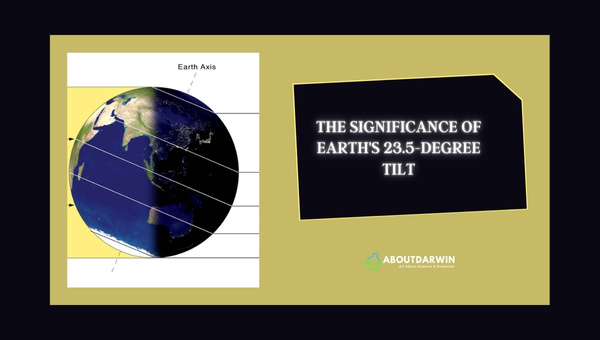Physical Address
304 North Cardinal St.
Dorchester Center, MA 02124
Earth’s 23.5° axis tilt shapes our planet’s climate, seasons, and environment. This Earth tilt, called obliquity, occurs because the Earth isn’t perfectly upright as it rotates around the Sun.
Instead, it’s tilted at an angle of approximately 23.5 degrees. As the planet orbits the Sun, this tilt causes the intensity of sunlight to vary across its surface, creating the distinct seasons we experience throughout the year.
Because of the 23.5° axis tilt, different hemispheres receive more sunlight during specific times of the year, leading to warmer temperatures and longer days in one part, while cooler temperatures and shorter days occur in the other.
This tilt also significantly impacts the polar regions by affecting the amount of sunlight and resulting in the dramatic temperature fluctuations experienced at the Poles.
The more we understand the significance of Earth’s 23.5° axis tilt, the better we can comprehend our planet’s diverse climates and ecosystems. It defines the varied weather patterns and habitats we see today and serves as an essential factor in the evolution and survival of countless plant and animal species.
Earth’s tilt is vital in how our planet experiences seasons, daylight hours, and climate variations. Let’s explore the key factors that make Earth’s 23.5° axial tilt so significant.

Seasons are a direct result of the Earth’s tilt on its axis. As our planet revolves around the Sun, the tilted axis causes different parts of the Earth to get varying amounts of sunlight throughout the year. For instance:
The Earth’s axial tilt also influences daylight hours. At different points in Earth’s orbit, other regions experience more or less daylight:
This phenomenon creates a stark contrast between seasons, such as the long daylight hours in the Arctic during summer and complete darkness during winter.
| Solstice | Hemisphere | Daylight Hours |
|---|---|---|
| Summer | Northern | Longer |
| Winter | Northern | Shorter |
| Summer | Southern | Shorter |
| Winter | Southern | Longer |
In part, climate variations can also be attributed to Earth’s tilt. Earth’s axial tilt causes a difference in solar radiation received by various latitudes, which in turn creates some notable climate patterns:
Earth’s 23.5° tilt is responsible for a diverse and ever-changing environment. Without the tip, the balanced mix of climates and seasonal variations we experience on our planet would radically differ. In addition, the tilt facilitates a wide range of ecosystems, supporting an array of distinctive flora and fauna.
The Density of Earth: Insights into Our Earth’s Constituents
Earth’s 23.5° axial tilt plays a significant role in forming our planet’s climate and seasonal changes. In this section, I’ll guide you through how this tilt impacts various aspects of our environment, from temperature shifts to the distribution of sunlight.

The axial tilt allows different parts of Earth to receive varying amounts of sunlight throughout the year. During summer, a hemisphere is tilted towards the sun, leading to increased sunlight and higher temperatures. In contrast, a hemisphere leaned away from the sun experiences winter, with less sunlight and lower temperatures.
Some essential effects of the Earth’s tilt on climate and seasons include:
To illustrate the impact of Earth’s tilt on climate and seasons more clearly, I’ve put together a table comparing temperature and daylight variations at the solstices and equinoxes, taking New York City as an example:
| Event | Average Temperature (°F) | Daylight Hours |
|---|---|---|
| Summer Solstice | 78 | 15h 5m |
| Winter Solstice | 38 | 9h 15m |
| Spring Equinox | 54 | 12h 8m |
| Autumn Equinox | 69 | 12h 8m |
It’s also worth mentioning that the Earth’s tilt slowly changes over time. This phenomenon is called axial precession, which occurs every 26,000 years. As the tilt varies between 22.1° and 24.5°, Earth’s climate goes through long-term changes, contributing to global temperature fluctuations and weather patterns.
So, in a nutshell, Earth’s 23.5° axial tilt significantly shapes the distribution of sunlight, temperature variations, and seasonal changes that contribute to our planet’s diverse climatic conditions. Without this tilt, life on Earth would be drastically different, and understanding its impact helps us appreciate the unique environment that sustains our existence.
10 Asthenosphere Facts: Exploring the Earth’s Mysterious Layer
It’s now evident that Earth’s tilt, at approximately 23.5 degrees, plays a significant role in shaping our planet’s diverse weather patterns and seasons. Let’s recap some key points:
Here are some significant effects of Earth’s tilt on our daily lives:
In understanding the complexities of Earth’s tilt, we gain insights into the forces that have shaped our planet’s climate, ecosystems, and even the development of human civilization.
While it’s just one aspect of Earth’s incredible dynamics, the 23.5° axis has profoundly impacted life as we know it. We can now more fully appreciate the subtleties of Earth’s behavior and the delicate balance crucial for our existence.
By grasping the significance of this tilt, we, as stewards of our planet, can better comprehend and address various environmental issues that arise from climate change and other impacts on Earth’s delicate balance.